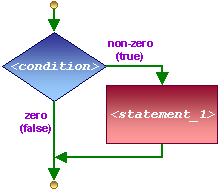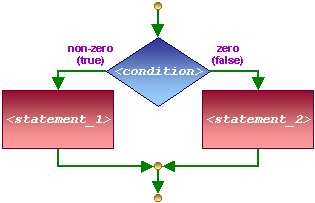The selection structures provided in C++ are similar to those in Pascal.
 Single-way selection
Single-way selection | C++ control structure | Equivalent Pascal control structure |
| if (<condition>) <statement_1>; |
if <condition> then <statement_1> |
<statement_1> will be executed if <condition> is non-zero (i.e. true). Note that in C++, then is not required but the parentheses around the condition is necessary.
<statement_1> can be a compound statement if more than one statement are to be executed when the condition is true. This applies to all kinds of control structures.
Sample program:
| C++ version | Pascal version |
| #include <iostream.h> main() { int OT_hours, wages = 8000; cout << "Number of overtime hours? "; cin >> OT_hours; if (OT_hours > 30) { cout << "Maximum OT hours is 30" << endl; OT_hours = 30; } wages += OT_hours * 50; cout << "Wages: $" << wages << endl; return 0; } |
program prog_11(input, output); var OT_hours, wages: integer; begin wages := 8000; write('Number of overtime hours? '); readln(OT_hours); if OT_hours > 30 then begin writeln('Maximum OT hours is 30'); OT_hours := 30 end; wages := wages + OT_hours * 50; writeln('Wages: $', wages); end. |
| Sample output 1 (text in red is entered by user): | |
| Number of overtime hours? 50 Maximum OT hours is 30 Wages: $9500 |
|
| Sample output 2 (text in red is entered by user): | |
| Number of overtime hours? 12 Wages: $8600 |
|
 Two-way selection
Two-way selection | C++ control structure | Equivalent Pascal control structure |
| if (<condition>) <statement_1>; else <statement_2>; |
if <condition> then <statement_1> else <statement_2> |
If <condition> is non-zero (i.e. true), <statement_1> is executed. Otherwise, <statement_2> is executed.
A statement using the conditional operator can be replaced by this selection structure. For example, Program 9 can be rewritten as follows:
| C++ version | Pascal version |
| #include <iostream.h> main() { int x, y, min; cout << "Enter x: "; cin >> x; cout << "Enter y: "; cin >> y; if (x < y) min = x; else min = y; cout << x; if (x > y) cout << " > "; else cout << " <= "; cout << y << endl; cout << min << " is the smaller number." << endl; return 0; } |
program prog_12(input, output); var x, y, min: integer; begin write('Enter x: '); readln(x); write('Enter y: '); readln(y); if x < y then min := x else min := y; write(x); if x > y then write(' > ') else write(' <= '); writeln(y); writeln(min, ' is the smaller number.') end. |
| Sample output 1 (text in red is entered by user): | |
| Enter x: 10 Enter y: 5 10 > 5 5 is the smaller number. |
|
| Sample output 2 (text in red is entered by user): | |
| Enter x: 4 Enter y: 7 4 <= 7 4 is the smaller number. |
|
Like Pascal, C++ also supports nested control structures.
We can use nested if-else statements for multiple cases. For example, the following program outputs a grade according to the input score. The indentation shows how the if-else statements are nested.
| C++ version | Pascal version |
| #include <iostream.h> main() { int score; char grade; cout << "Score? "; cin >> score; if (score >= 80) grade = 'A'; else // score < 80 if (score >= 70) grade = 'B'; else // score < 70 if (score >= 60) grade = 'C'; else // score < 60 if (score >= 50) grade = 'D'; else // score < 50 grade = 'F'; cout << "Grade: " << grade << endl; return 0; } |
program prog_13; var score: integer; grade: char; begin write('Score? '); readln(score); if score >= 80 then grade := 'A' else (* score < 80 *) if score >= 70 then grade := 'B' else (* score < 70 *) if score >= 60 then grade := 'C' else (* score < 60 *) if score >= 50 then grade := 'D' else (* score < 50 *) grade := 'F'; writeln('Grade: ', grade) end. |
| Sample output 1 (text in red is entered by user): | |
| Score? 74 Grade: B |
|
| Sample output 2 (text in red is entered by user): | |
| Score? 32 Grade: F |
|
But to enhance readability, the nested if-else statements are usually written
as follows:
if (score >=80)
grade = 'A';
else if (score >= 70)
grade = 'B';
else if (score >= 60)
grade = 'C';
else if (score >= 50)
grade = 'D';
else
grade = 'F';